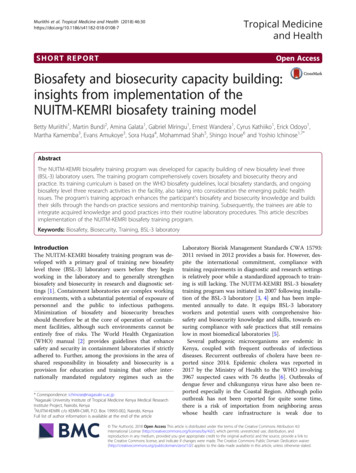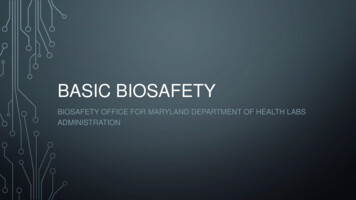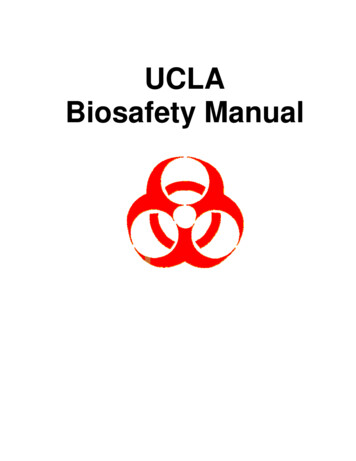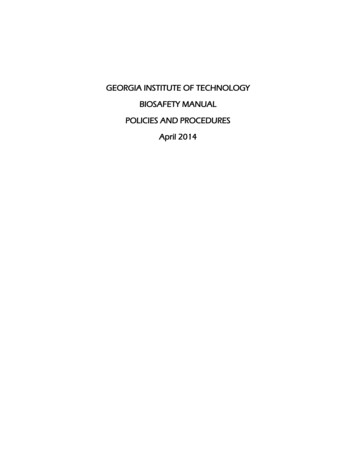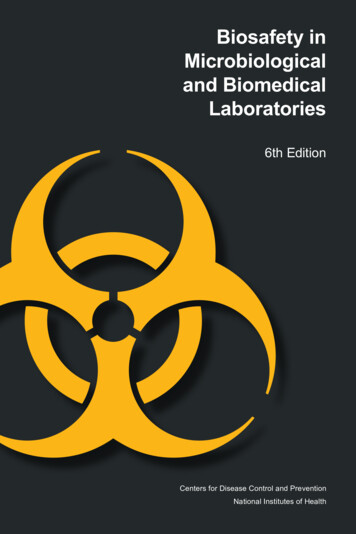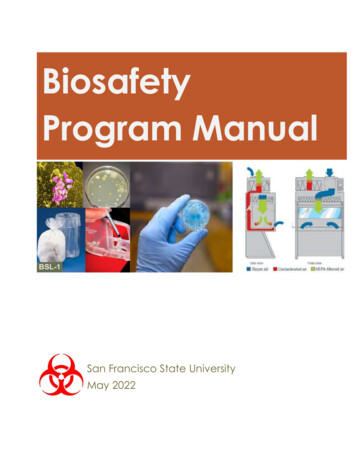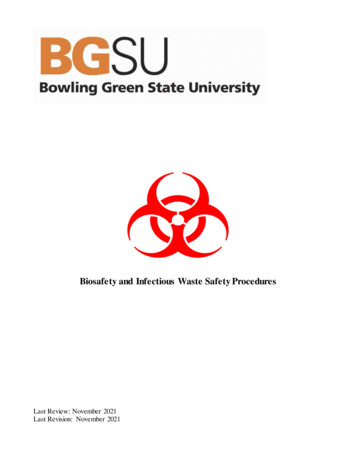
Transcription
Biosafety and Infectious Waste Safety ProceduresLast Review: November 2021Last Revision: November 2021
Table of ContentsFOREWORD . 1OVERVIEW . 1BIOSAFETY PROCEDURES. 3Biosafety Level 1 (BSL-1). 3Biosafety Level 2 (BSL-2). 3Biosafety Level 3 (BSL-3). 3Biosafety Level 4 (BSL-4). 3INFECTIOUS WASTE AND AUTOCLAVE PROCEDURES 4Purpose. 4Storage of Infectious Waste. 4Departmental Infectious Waste Disposal Procedures . 4Spill Containment and Cleanup . 4Sources . 8
INTRODUCTIONForewordIn 1970, the United States Congress established the right of workers to "safe and healthful working conditions"through the Occupational Safety and Health Act. This act created the Occupational Safety and HealthAdministration (OSHA). In July 1994 the State of Ohio adopted and incorporated by reference many of theFederal OSHA standards through the Public Employee Risk Reduction Act, Ohio Revised Code 4167.07. Thisact and its subsequent rules (Ohio Administrative Code 4167-3-01) required Bowling Green State Universityand other state institutions to comply with all applicable OSHA standards.The Biosafety and Infectious Waste Safety Procedures in this document have been established by BowlingGreen State University to comply with Ohio’s Public Employee Risk Reduction Act, the U.S Department ofHealth and Human Services manual on “Biosafety in Microbiological and Biomedical Laboratories”, the NIHGuidelines for Research Involving Recombinant or Synthetic DNA Molecules, the OSHA OccupationalExposure to Hazardous Chemicals in Laboratories Standard 29 CFR 1910.1450, and the OSHA PersonalProtective Equipment Standards of 29 CFR 1910 subpart I.Certain safety and health hazards exist in the University laboratories and must be addressed. Everyone involvedin any aspect of lab functioning has a legal and moral responsibility to act in such a way to reduce risks frompotential hazards in the laboratory.The procedures are designed to accommodate the specific laboratory activities relevant to biohazardous materialon campus and to minimize unnecessary burdens placed on departments or researchers. Although the tasks ofusing biohazardous material are more specialized than general laboratories, it is important to understand that therespective laboratory is still responsible to establish general safe operating procedures and provides guidelinesfor the development of specific laboratory procedures, per the BGSU Laboratory and Chemical Hygiene Plan.The responsibility for ensuring safety in the laboratory ultimately rests with the individual in charge of thatlaboratory.Ensuring safety through health hazard reduction should be viewed as a good prudent professional practice, notas merely an additional administrative requirement. Risks can never be reduced to zero, but by practicingsimple and safe laboratory procedures, they can be reduced dramatically. The intent of these procedures is tohelp laboratories using biohazardous material to reach a level of safety and risk minimization that is entitled toall workers.OverviewAll laboratories using biological substances for research activities, no matter what level of hazard, need to abideby the Environmental Health and Safety’s Lab Safety and Chemical Hygiene Plan. All biological wastegenerated by these laboratories need to follow written procedures established by the Environmental Health andSafety Hazardous Waste Management procedures. Additionally, guidelines and regulations outlined by theInstitutional Biosafety Committee (IBC) may have to be followed.Prior to purchasing biological agents for a non-designated laboratory for the first time, a written request isrequired to be sent to the IBC. Furthermore, if an approved lab is wanting to use agents in a higher level than1
permitted, they will have to submit a new proposal to the IBC. Once approved, the requestor must follow BGSUPurchasing protocol for purchasing hazardous goods.The laboratory director is specifically and primarily responsible for the safe operation of the laboratory. His/herknowledge and judgment are critical in assessing risks and appropriately applying these recommendations. Therecommended biosafety level represents those conditions under which the agent can ordinarily be safelyhandled. Special characteristics of the agents used, the training and experience of personnel, procedures beingconducted, and the nature or function of the laboratory may further influence the director in applying theserecommendations.The following requirements and definitions are derived from the guidelines defined by the BGSU IBC. TheDepartment of Environmental Health and Safety, although part of the approval process, refers to the IBC todetermine whether laboratories requesting BSL-1 or BSL-2 specimens meet these requirements. Please refer tothe most updated requirements by visiting the Office of Research Compliance website.2
BIOSAFETY LEVELSBiosafety Level 1 (BSL-1)BSL-1 is suitable for work involving well-characterized agents not known to consistently cause disease inimmunocompetent adult humans, and present minimal potential hazard to laboratory personnel and theenvironment. BSL-1 laboratories are not necessarily separated from the general traffic patterns in the building.Work is typically conducted on open bench tops using standard microbiological practices. Special containmentequipment or facility design is not required but may be used as determined by appropriate risk assessment.Laboratory personnel must have specific training in the procedures conducted in the laboratory and must besupervised by a scientist with training in microbiology or a related science.Biosafety Level 2 (BSL-2)Primary hazards to personnel working with BSL-2 agents relate to accidental percutaneous or mucousmembrane exposures, or ingestion of infectious materials. Extreme caution should be taken with contaminatedneedles or sharp instruments. Even though organisms routinely manipulated at BSL-2 are not known to betransmissible by the aerosol route, procedures with aerosol or high splash potential that may increase the risk ofsuch personnel exposure must be conducted in primary containment equipment, or in devices such as a BSC orsafety centrifuge cups. Personal protective equipment should be used as appropriate, such as splash shields, faceprotection, gowns, and gloves.Biosafety Level 3 (BSL-3)BGSU does not have any laboratories authorized for use of BSL-3 agents.BSL-3 is applicable to clinical, diagnostic, teaching, research, or production facilities where work is performedwith indigenous or exotic agents that may cause serious or potentially lethal disease through the inhalation routeof exposure. Laboratory personnel must receive specific training in handling pathogenic and potentially lethalagents and must be supervised by scientists competent in handling infectious agents and associated procedures.Biosafety Level 4 (BSL-4)BGSU does not have any laboratories authorized for use of BSL-4 agents.BSL-4 practices, safety equipment, and facility design and construction are applicable for work with dangerousand exotic agents that pose a high individual risk of life-threatening disease, which may be transmitted via theaerosol route and for which there is no available vaccine or therapy. Agents with a close or identical antigenicrelationship to BSL-4 agents also should be handled at this level. When sufficient data are obtained, work withthese agents may continue at this level or at a lower level. Viruses such as Marburg or Congo-Crimeanhemorrhagic fever are manipulated at BSL-4.The primary hazards to personnel working with BSL-4 agents are respiratory exposure to infectious aerosols,mucous membrane or broken skin exposure to infectious droplets, and autoinoculation. All manipulations ofpotentially infectious diagnostic materials, isolates, and naturally or experimentally infected animals, pose ahigh risk of exposure and infection to laboratory personnel, the community, and the environment. Thelaboratory worker’s complete isolation from aerosolized infectious materials is accomplished primarily byworking in a Class III BSC or in a full-body, air-supplied positive-pressure personnel suit. The BSL-4 facilityitself is generally a separate building or completely isolated zone with complex, specialized ventilationrequirements and waste management systems to prevent release of viable agents to the environment.3
INFECTIOUS WASTE AND AUTOCLAVE PROCEDURESPurposeThe purpose of the procedures listed below are to outline the proper protocols implemented at BGSU for thesafe use of autoclaves to treat hazardous biological waste. Chemical waste is strictly prohibited. This is inguidance with the latest version of the Ohio EPA regulations, per the Ohio Administrative Code Chapter 374527 and other hazardous waste regulations.Storage of Infectious WasteAll waste shall be placed in either an autoclave bag or sharps container labelled with the biohazard symbol.Bags shall be kept tied shut and sharps containers kept closed. There should not be holes in any of the biohazardbags. All infectious waste shall be stored in a designated storage area that is either kept locked or visiblylabelled with a sign stating “Warning: infectious waste” or with the international biohazard symbol at all pointsof access. Infectious waste must be protected from animals and does not provide a breeding place or foodsource for insects or rodents. Waste shall be stored no more than 14 days. The volume of waste stored should beno more than seven times what the treatment facility can autoclave in one day.Departmental Infectious Waste Disposal ProceduresIf biohazardous waste is generated on-campus, it needs to be disposed of responsibly. It may be autoclaved ifthe material is handled properly. It should also be noted that the respective department for the autoclave beingused to treat the waste may charge a fee to the department for disposal.To ensure that the biohazardous or infectious waste is being cared of properly and that personnel handling thewaste are kept safe, listed below are the procedures that need to be followed when accumulating or treatingbiohazardous or infectious waste at Bowling Green State University.1. Waste accumulation areas, including the containers used for collecting waste, need to be labeledproperly. This includes signs posted stating that the waste bin is for biohazardous waste and ensuringthat waste bags used are labeled biohazardous.2. If you are generating waste in the same building as the autoclave you will be dropping waste off at, youmay personally walk the waste to the autoclave. If you are generating waste in a building other thanwhere the autoclave is located, you may contact Environmental Health and Safety (2-2171) to ensure thewaste is delivered properly.3. Biohazardous and infectious waste bags will be rejected if over-filled or if leaking upon arrival to theautoclave.4. The manager of the autoclave needs to log what type of waste is being autoclaved. It is imperative thatthe generator records this information once the waste is dropped off.Spill Containment and CleanupThe procedures outlined below shall be followed in the event of a biological spill or accident (unless thequantity of such spills is less than one cubic foot of waste or less than one half the contents of a container with amaximum capacity of two cubic feet).Call for emergency help as needed from the autoclave coordinator/department contact, the EnvironmentalHealth and Safety office on campus, or the BGSU police department. See the emergency phone numbers sectionfor numbers outside of the University.4
EHS SPECIALISTTBDEnv. Health & SafetyTBD(419) 372- 2171 EHS OfficeLIFE SCIENCECOORDINATORTBDBiological SciencesTBD(419) 372-2332 Dept. OfficeMOSELEY HALLCOORDINATOREmily Barnes-HannaMedical Laboratory Sciences(419) 372- 8554(419) 372-8724 Dept. OfficeEmergency Telephone NumbersBGSU Biology Department .(419) 372-2332BGSU Microbiology Prep Room .(419) 372-8609BGSU Health and Human Services Department .(419) 372-8724BGSU Environmental Health and Safety .(419) 372-2171BGSU Police Department .(419) 373-2346The emergency response companies that may be contacted in the event of an infectious waste spill are:Environmental Management Specialists, Inc.Office: 419-386-233124/7 Dispatch: 877-816-9111Rader Environmental ServicesOffice: 419-424-1222Joe Rader: 419-408-1169Ed Cheney: 419-408-1171Implementation of ResponseBIOLOGICAL SPILLS or LEAKS1. Evacuate to a safe distance.2. CALL 911 – Give location and description of material.3. Prevent access to area until response team arrives.4. If biological material contacts eyes or skin, flush immediately and continuously for at least 15 minutes. Useeye wash station, safety shower or other water source.5
Spill Procedures1. CLEANUP KIT is required to be available for the autoclave and suggested as a best practice for individuallaboratories. An example of what a cleanup kit may contain include:A.HAZORB SPILL ABSORBENT.B.DISINFECTANT - 10% household bleach solution – make fresh as neededC.BIOHAZARD BAGS (a minimum of 10)D.FIRST AID KIT and FIRE EXTINGUISHERE.PROTECTIVE BODY EQUIPMENT (a minimum of one set)Disposable overallsDisposable bootsDuct tapeGlovesDisposable capsBoundary tapeProtective eye wear2. LIMIT ACCESS TO SPILL AREALimit access to spill area to clean-up crew and personnel from Environmental Health and Safety. Seal off areawith boundary tape. Close room until spill area is disinfected.3. BROKEN CONTAINERSMinimizing the risk of exposure, place broken containers and spillage inside the appropriate infectious wastecontainers.4. ABSORB SPILLHazorb absorbent should be gently tossed on spill area so that spill is covered. Area should be left untouchedjust long enough for spilled liquid to be absorbed. Clean up all solids and liquids with disposable paper towels.After use the absorbent material and paper towels shall be considered infectious waste. These materials shouldbe placed in the biohazard bag for treatment as infectious waste while minimizing exposure to cleanuppersonnel.5. DECONTAMINATE AREADecontaminate area by flooding the area with a 10% bleach solution or other approved disinfectant. Allow thedisinfectant solution to be in contact with the affected area for a minimum of 15 minutes.6. CLEANING THE AREAWipe up the disinfectant with disposable paper towels. Place all disposable cleanup materials in biohazard bags.7. DISINFECT ALL NON-DISPOSABLE EQUIPMENT.All equipment that cannot be autoclaved should be sprayed with disinfectant. Allow disinfectant to contact thecontaminated equipment for at least 30 minutes.6
8.DISCARD PROTECTIVE EQUIPMENT AS INFECTIOUSRemove personal protective equipment and place disposables in biohazard bags to be autoclaved as infectiouswaste.9. AUTOCLAVE CLEANUP MATERIALS.Once the cleanup is complete and all infectious materials are contained in biohazard bags - autoclave asinfectious waste.10. REPORT ALL INFECTIOUS SPILLS/ACCIDENTSReport to the respective infectious waste coordinator within 48 hours using the accident/spill form, unless thequantity of such spills is less than one cubic foot of waste, or less than one half the contents of a container witha maximum capacity of two cubic feet. Any infectious waste spill outside of the limited access areas shall bereported.11. RECORD ALL SPILLS/ACCIDENTS INVOLVING INFECTIOUS MATERIALS IN SPILL LOGAll spills related to the autoclave shall be recorded in the Spill Log located in the Facility Management Planbinder. Maintain records for a minimum of three years.12. REPLENISH CONTAINMENT AND CLEANUP KIT.7
SourcesLaboratory Biosafety Manual. 3rd ed. Geneva: World Health Organization; 2004.Sewell, David L. "Laboratory-associated infections and biosafety." Clinical Microbiology Reviews 8.3 (1995):389-405.American Biological Safety Association. ABSA Biosecurity Task Force White Paper: UnderstandingBiosecurity. Illinois: The Association; 2003.http://www.absa.org/0301bstf.htmlBiosafety in Microbiological and Biomedical Laboratories, 5th ed. Washington, DC, United States Departmentof Health and Human Services/Centers for Disease Control and Prevention/National Institutes of Health, 2009.8
bags. All infectious waste shall be stored in a designated storage area that is either kept locked or visibly labelled with a sign stating "Warning: infectious waste" or with the international biohazard symbol at all points of access. Infectious waste must be protected from animals and does not provide a breeding place or food
